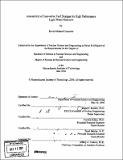Assessment of innovative fuel designs for high performance light water reactors
Author(s)
Carpenter, David Michael
DownloadFull printable version (9.704Mb)
Other Contributors
Massachusetts Institute of Technology. Dept. of Nuclear Science and Engineering.
Advisor
Mujid S. Kazimi.
Terms of use
Metadata
Show full item recordAbstract
To increase the power density and maximum allowable fuel burnup in light water reactors, new fuel rod designs are investigated. Such fuel is desirable for improving the economic performance light water reactors loaded with transuranic-bearing fuel for transmutation, as well as those using UO2 fuel. A proposal for using silicon carbide duplex as fuel cladding is investigated. The cladding consists of a monolithic inner layer surrounded by a tightly wound fiber-matrix composite. The monolith layer retains the volatile fission products while the composite adds strength. The FRAPCON steady-state thermo-mechanical fuel rod modeling code is used to examine the performance of SiC cladding at high fuel burnup and high power density. Empirical models are developed to describe the physical properties of the composite as a function of operating temperature and neutron fluence. A comparison of the behavior of the SiC cladding to the conventional Zircaloy cladding demonstrates that the SiC has superior resistance to creep and mechanical degradation due to radiation or oxidation. However, the lower thermal conductivity of the SiC is a major issue, which results in significantly increased peak fuel temperatures. Mixed U02-PuO2 fuel is also examined in place of traditional UO2 pellets, since this may better resemble transmutation fuels of the future. It is found that the use of plutonium-bearing mixed-oxide fuels further exacerbates the high fuel temperatures. The silicon carbide cladding is predicted to have more favorable performance when used for internally- and externally-cooled annular fuel rods developed at MIT. Both sintered annular pellets and VIPAC granular fuel are examined. (cont.) Because of the fuel geometry, the average fuel temperature is significantly lower, and the stiffness of the SiC cladding helps to maintain the geometry of the annulus during extended irradiation. Experimental projects have been undertaken to study the performance of both the annular fuel rods and silicon carbide duplex cladding. A post-irradiation examination of prototype annular fuel rods with VIPAC fuel, irradiated in the MIT reactor, has been designed and executed. Through this non-destructive examination, the disposition of the fuel grains is examined, and fuel burnup and fission gas release is estimated. These experimental results correlate well with computer calculations. A new irradiation facility was also planned and constructed that consists of a closed loop, operated at pressurized water reactor pressure, temperature, and chemistry conditions. This facility contains silicon carbide duplex cladding samples of various constructions, and it will be irradiated in the core of the MIT reactor for several months.
Description
Thesis (S.M. and S.B.)--Massachusetts Institute of Technology, Dept. of Nuclear Science and Engineering, 2006. Includes bibliographical references (p. 179-183).
Date issued
2006Department
Massachusetts Institute of Technology. Department of Nuclear Science and EngineeringPublisher
Massachusetts Institute of Technology
Keywords
Nuclear Science and Engineering.